Nelson Mandela once said, “Sport has the power to change the world.” This idea is very true in the world of sports sponsorship in emerging markets. Today, we see a big change happening in places like Asia, Africa, and South America. These changes offer big chances for brands to grow by using sports marketing opportunities in emerging markets.
With more money to spend and a bigger interest in sports, companies want to get into sports sponsorship deals in emerging markets. This area is very important because of big events like Super Bowl LXII in 2028, which will be in Atlanta. This shows how these markets are becoming more important worldwide1.
NFL teams are showing they really care about these markets by working harder to reach fans globally and getting more viewers. This shows a big change towards using these markets’ potential2. As the world gets smaller, brands have a great chance to use sports to connect with people and show off their brand. This is just the start of a very exciting time for sports sponsorship.
Understanding the Growth of Emerging Markets in Sports Sponsorship
The growth of sports sponsorship in emerging markets shows a changing economic scene. Brands are now looking at new strategies because of this. In developing countries, a growing middle class is spending more on sports, offering big chances for brands.
Digital platforms have changed how brands talk to fans. They use social media to reach out to sports fans in ways they couldn’t before. This is especially true in places where old media is hard to find.
Building sports facilities is also key to growth. Countries are making new venues for big sports events. This helps them show off to the world.
Atlanta is getting ready for Super Bowl LXII in 2028. It’s building hotels and the Centennial Yards project to host the event1.
More NFL teams are hiring people from around the world and planning for global markets1. In 2023, sports travel hit 205 million trips. This shows sports are big for business and engagement in these areas3.

USA Football’s outreach program is a success story. It signed up 6,000 youth groups and helped over 1.5 million players. This shows how grassroots efforts can boost sponsorship chances. Understanding these trends helps brands make smart choices in sports sponsorship.
Key Characteristics of Emerging Markets
Emerging markets are unique for sports sponsorship deals. They often have economic ups and downs, offering both challenges and chances for marketers. It’s key to know what local consumers like, as tastes can change fast.
Marketers face a diverse crowd, affecting how people buy things. This means creating strategies that fit each area is vital.
Sports sponsorship in these markets needs to understand local culture. People want brands that get what’s real and valued in their community. It’s important to connect with fans in a way that shows you care about their culture.
Looking into these traits shows how emerging markets are different from more developed ones. Sponsors can’t just use the same plan everywhere. They must get to know what’s popular and what people want.
By making sponsorship plans that fit each place, you can build strong bonds with people. This is especially true in markets that are always changing.
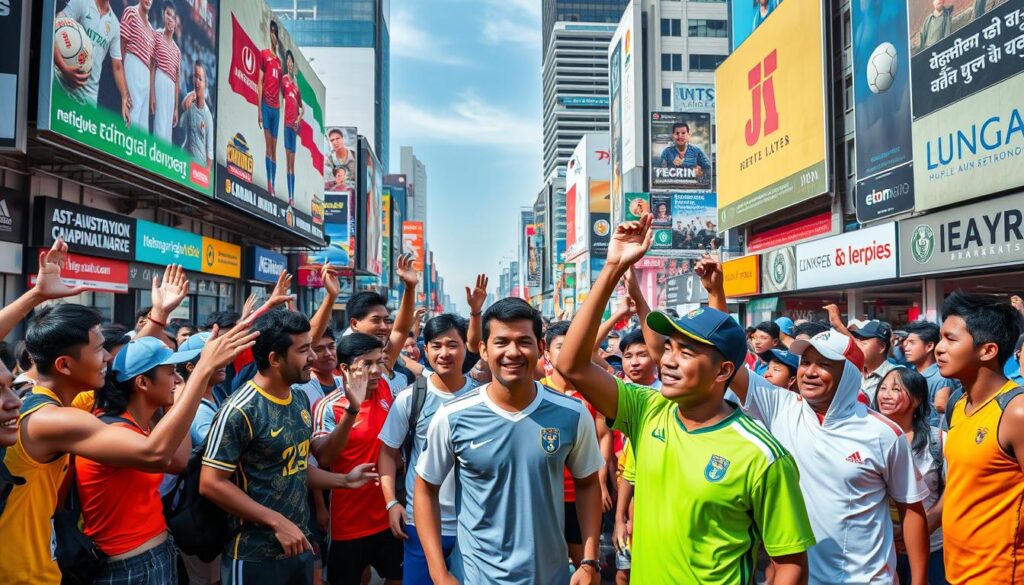
Sports Sponsorship Deals in Emerging Market
Emerging markets are changing the sports sponsorship world. They bring new trends and successful partnerships. It’s key for brands to understand these sports sponsorship strategies for emerging markets to reach new fans.
Trends Influencing Sponsorship Decisions
One big trend is the move to digital engagement. Brands now use social media and online platforms more than traditional ads. This helps them connect with local fans and build loyalty, especially in Asia and Africa where digital use is growing fast.
Another trend is the importance of community-driven initiatives. Brands are now linking their sponsorships with local values and events. This makes them more relatable to consumers. For instance, big companies are doing more community work alongside their sponsorships to boost their image.
Case Studies of Successful Sponsorship Deals
There are many examples of notable sports sponsorships in developing countries. Coca-Cola’s partnership with the FIFA World Cup in Africa is one. It helped Coca-Cola reach more people while promoting its brand locally.
Unilever’s deal with Indian sports leagues is another success story. By creating campaigns that celebrate cricket and involve local players, Unilever connected with India’s love for the sport. Such strategies show how effective sponsorship can increase brand value and recognition in new markets.

The Role of Technology in Sports Sponsorship
Technology is changing sports sponsorship, especially in new markets. Brands are using digital marketing that fits local tastes and cultures. This approach boosts visibility and creates new chances for sports marketing in these areas.
Digital Marketing Strategies for Emerging Markets
Digital marketing is becoming key in sports sponsorship in new markets. Companies make content that speaks to local people, using ads to get fans involved. This approach is working, with digital sponsorship bringing in more money.
Global brands are making mobile apps for local sports events. These apps give fans a deep dive into the action.
Leveraging Social Media for Fan Engagement
Social media is vital for brands to connect with fans. Platforms like Instagram and WeChat help reach local fans. Campaigns that use fun, local content get more people involved.
By 2023, digital platforms are the top way for brands to promote themselves. Many users are talking about sports online1. This not only builds fan loyalty but also gives brands useful data for future plans4. Studies show that using these technologies can really help brands succeed in sponsorship.

Challenges in Emerging Market Sports Sponsorship
Brands face unique hurdles when they try to sponsor sports in emerging markets. These issues come from cultural differences and economic ups and downs.
Cultural Differences Impacting Sponsorship Strategies
Cultural diversity is key in sports sponsorship. Each market has its own traditions and values. Brands need to research and connect with local communities to create strategies that work.
Ignoring these cultural aspects can make campaigns fail. They won’t connect with the audience.
Economic Factors Affecting Investment
Economic factors in emerging markets affect sports sponsorship. Things like currency changes and different rules make it hard to invest. This can lead to unexpected costs and affect planning.
For example, Premier League clubs spent £45m on legal fees last season. This was way more than their £8m budget4. It shows the importance of careful planning and risk management in new markets.

| Challenge | Description | Potential Solutions |
|---|---|---|
| Cultural Sensitivity | Understanding local customs and practices that influence consumer behavior. | Conduct market research and engage local marketing experts. |
| Economic Instability | Dealing with fluctuating currencies and economic policies that can affect investment. | Implement financial risk management strategies and flexible budgets. |
| Regulatory Challenges | Navigating different legal frameworks that govern sponsorship agreements. | Collaborate with local legal experts to ensure compliance and reduce risks. |
Brands must familiarize themselves with these challenges to effectively mitigate risks and optimize sponsorship success.
Sports Marketing Opportunities in Emerging Markets
Emerging markets offer exciting chances for sports marketing. They can boost brand visibility and engagement. With major events like the NFL’s Super Bowl LXII in 2028 in Atlanta, brands can reach more fans through strategic sponsorships1.
Atlanta will also host big events like the SEC Football Championship and the Chick-fil-A Peach Bowl. These events provide more chances for brands to get noticed1.
The NFL is focusing more on global markets, hiring staff for global branding and revenue growth1. This shift opens up opportunities for partnerships that blend local sports enthusiasm with global brand stories. It can strengthen community bonds and increase brand loyalty.
WWE’s first two-night SummerSlam in New Jersey shows the potential for brands to use sponsorship opportunities7. MetLife Stadium’s history of hosting big events raises hopes for record-breaking attendance and engagement7.
As global organizations invest more in emerging markets, brands can find creative ways to attract consumers. Supporting local athletes and community engagement initiatives can deepen their impact. It’s crucial to understand local cultures and preferences to create campaigns that truly connect with consumers.

In summary, getting involved in the emerging market sports industry can help brands grow and build loyalty. By staying updated with current events and trends, you can place your brand in a favorable position in these dynamic markets.
| Event | Location | Date | Potential Audience Reach |
|---|---|---|---|
| Super Bowl LXII | Atlanta | 2028 | Over 100 million |
| SEC Football Championship | Atlanta | Annual | Thousands of fans |
| Chick-fil-A Peach Bowl | Atlanta | Annual | Thousands of fans |
| SummerSlam 2025 | MetLife Stadium, New Jersey | August 2-3, 2025 | 165 countries, 25 languages |
Notable Sports Sponsorships in Developing Countries
Emerging market sports sponsorships have caught the eye with their efforts in developing countries. Big brands are now backing local teams or events, which really connects with these communities. This partnership is a win for everyone. Brands get more visibility, and they help grow sports in these areas.
The NFL’s Global Markets program is a great example. It shows how sponsorships can work by using teams like the Detroit Lions for international branding. Many NFL teams are hiring more people to reach out globally. The Dolphins, Seahawks, and Vikings are adding staff to grow their international presence and income1.
Also, big sponsorship battles, like Texas vs. Texas A&M, show the competitive side of sports. This contest uses a points system and gets support from Cotton Holdings. It shows how valuable it is to invest in local sports rivalries8. Texas A&M’s strong volleyball record this season adds to the excitement, showing the power of sponsorships in these markets8.
These sponsorships also help communities in big ways. They let brands connect with people in meaningful ways. By supporting local sports, companies improve their image and help society grow. These partnerships are becoming more important for businesses, as they boost loyalty and community growth9.
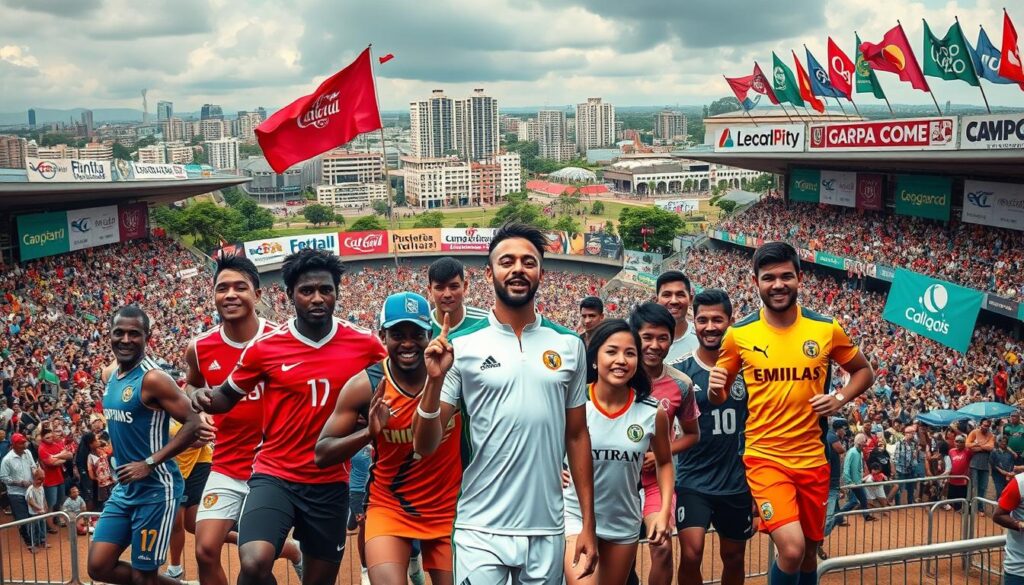
Analyzing Emerging Market Sports Sponsorship Trends
The world of sports sponsorship in emerging markets is always changing. This is because of new consumer tastes and big global events. Knowing these trends helps brands make better strategies. As tastes change, companies need to adjust to connect with their audience.
Shifts in Consumer Behavior
What people like in sports sponsorship changes due to culture, economy, and digital growth. In 2023, sports trips hit 205 million, showing a big interest in sports events3. Also, 63% of tourism groups say sports are key for more visitors3. Companies should use these facts to improve their sponsorship plans and connect with more fans.
Impact of Global Events on Local Sponsorship
Big events like the FIFA World Cup and Olympics boost local sponsorship. These events draw global fans and get local businesses involved. They make local markets more visible, leading to more investment and partnerships. For example, women’s sports are becoming more popular, thanks to the NCAA’s Emerging Sports for Women program3. Brands can gain a lot by linking local efforts with these big events.
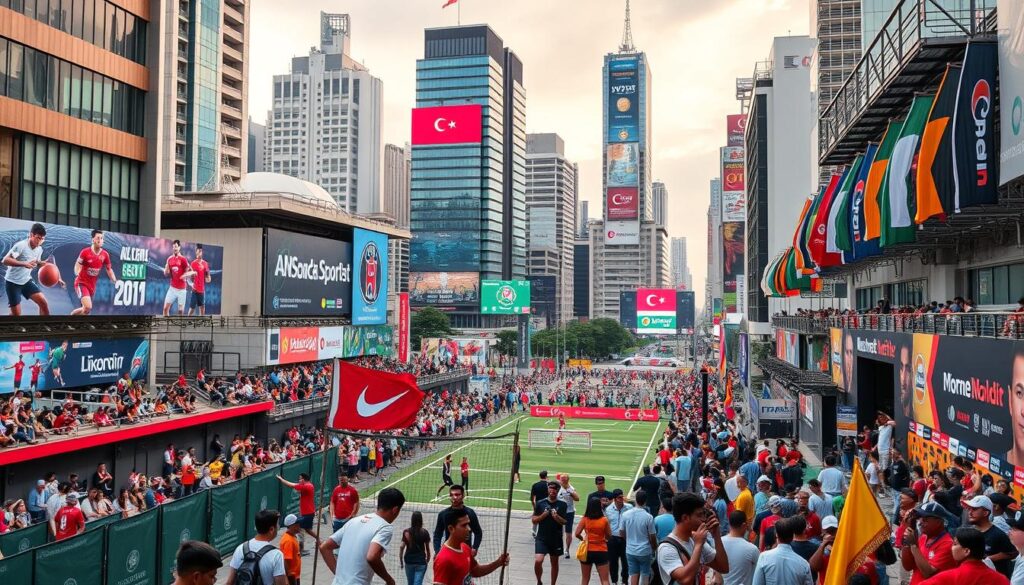
| Key Factors | Impact |
|---|---|
| Consumer Interest | Increased travel related to sports events and consumer engagement |
| Cultural Trends | Rising popularity of women’s sports and emerging disciplines |
| Global Events | Enhanced local sponsorship initiatives driven by international competitions |
By watching these trends, brands can make sponsorship campaigns that really speak to their audience. Being able to adapt to these changes is key to success in sports sponsorship in emerging markets10.
Strategies for Successful Sports Sponsorship in Emerging Markets
To succeed in emerging markets, brands need to use sports sponsorship strategies that connect with local people. Building strong ties with local groups is key. This builds trust and makes partnerships last longer.
It’s important to make messages that fit local cultures. Brands should really get to know the cultural details. This helps them connect better with fans. Making content that locals like boosts fan loyalty.
Using technology to talk to fans is a smart move. Social media lets brands interact directly with fans. This opens up new ways to market.
Using data to check how well sponsorships work is very helpful. Brands can use this info to improve their plans. A winning strategy includes knowing the local market, using tech, and being open to change.

Successful sponsorship strategies are grounded in knowledge, flexibility, and cultural awareness.
Getting involved in local sports events can help a brand grow. Hosting local sports events can get more people to know about the brand. This approach is key to good sponsorship in new markets111.
Sponsorship Opportunities in Emerging Market Sports Industry
The sports industry in emerging markets offers great chances for global brands to sponsor. Working with local groups can make your brand more popular. It also gives you insights into what people in the area like.
These partnerships help improve your marketing and make a positive impact on the community. They do this through sports programs and events.
Potential Partnerships with Local Organizations
Local partnerships in sports sponsorship help brands connect with communities more deeply. Some effective strategies include:
- Co-hosting community sporting events that fit local culture.
- Supporting grassroots programs to find and grow talent.
- Investing in sports facilities to improve health and wellness.
These efforts can bring in good returns. For example, Saru made R426 million from sponsorships in 2023, which was about 30% of its income. This shows how well partnerships can work12.
Companies like MTN and FNB spend tens of millions each year to support the Springboks. This shows their commitment to making a difference locally12.
By partnering locally, you build loyalty and a real connection with people. You help the community and show your brand’s values.
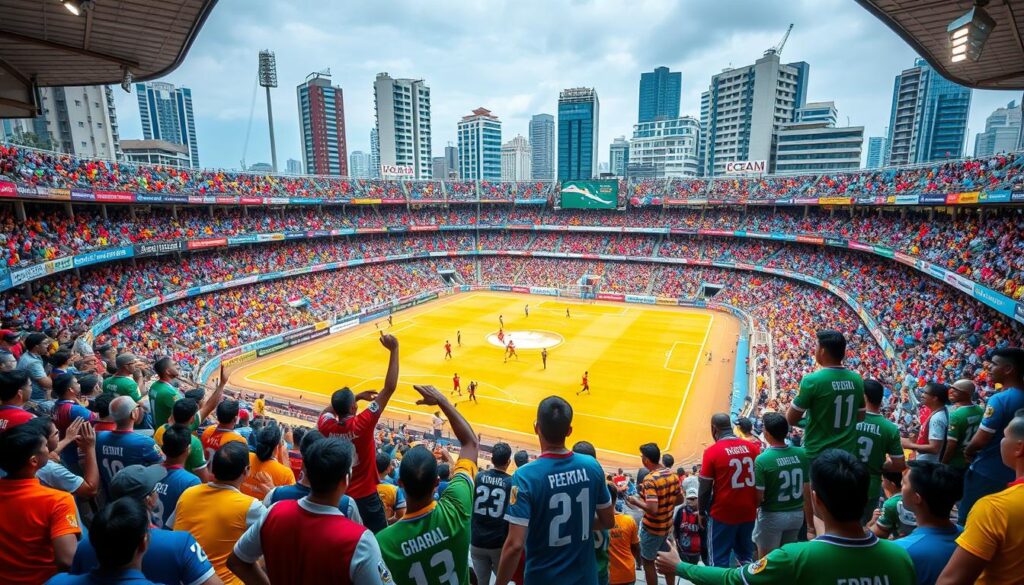
| Partnership Type | Impact Area | Example |
|---|---|---|
| Event Sponsorship | Community Engagement | Co-hosting local sports events |
| Grassroots Support | Talent Development | Training programs for youth |
| Facility Investment | Health & Wellness | Building sports complexes |
Entering the emerging market sports industry through local partnerships can be very rewarding. It aligns with community values, making your sponsorship both sustainable and impactful1314.
Impact of Economic Development on Sports Sponsorship
Economic growth is key in shaping sports sponsorship, especially in new markets. As these markets grow, sports sponsorship deals increase. This is due to more corporate investments and better economic stability.
For example, 63% of Destination Marketing Organizations (DMOs) say sports events are big for room bookings. This shows a strong demand for travel to sports events3. In 2023, sports-related travel hit 205 million, highlighting the big economic impact of sports3.
Groups like USA Wrestling are using this growth to push for women’s wrestling. They want NCAA Championship sanctioning to grow the sport3. The 2028 Olympic and Paralympic Games in Los Angeles will also boost several sports. Squash, cricket, football, and climbing will get more attention3.
Organizations like USA Football are also growing. They have over 6,000 youth football groups and reach 1.5 million players3. USA Climbing, led by CEO Marc Norman, saw a 100% revenue jump. They focus on high performance and development3. These stories show how economic growth opens up more chances for sports sponsorship.
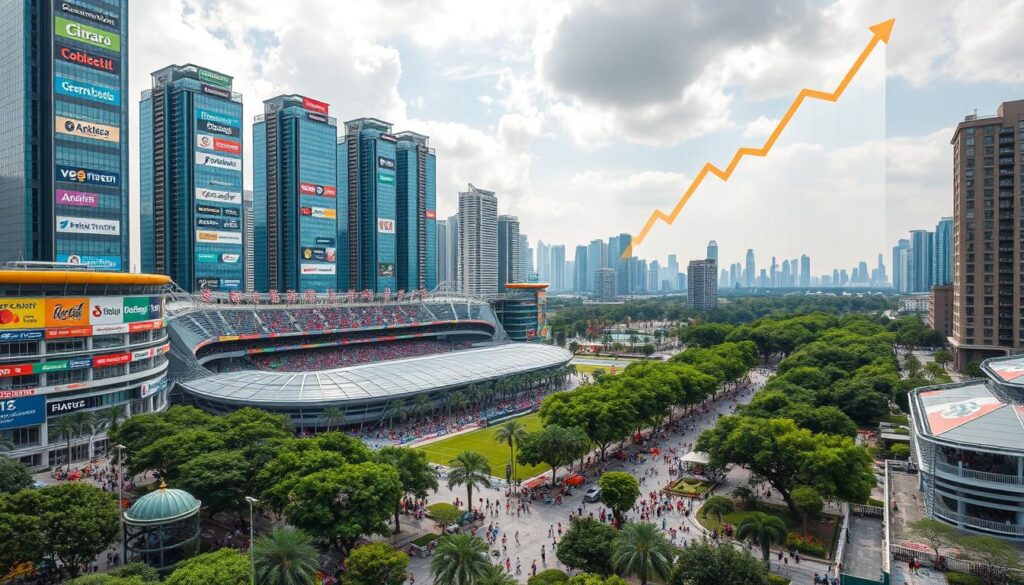
Future Predictions for Emerging Market Sports Sponsorship
The world of sports sponsorship in emerging markets is changing fast. This change comes from new demographics and a growing love for sports. The future looks bright, with big growth rates expected.
As countries grow economically and fans become more engaged, businesses are eager to invest. They see sports sponsorship as a great way to reach new audiences.
Projected Growth Rates
Soccer is becoming more popular, especially in the U.S. It’s expected to gain over 40 million fans by the 2026 World Cup15. Boston is already showing a strong interest in soccer, with a 23 percent higher interest in women’s sports. The World Cup is expected to bring in $1.1 billion to the local economy15.
Major League Soccer has grown from 4.5 million fans in 1996 to about 45 million today. It’s expected to gain another 15 million fans after the 2026 World Cup15.
The sports world is changing, with teams moving to new facilities. This shows a trend of investing in sports15. Kyrie Irving’s success with the Dallas Mavericks highlights the importance of players connecting with fans16.
Understanding players’ personal brands is key for successful sponsorships. This helps businesses make the most of their investments.
As consumer interests and economic trends align, sports sponsorship growth will continue. The U.S. is seeing a 3% annual GDP growth, creating a good environment for sponsorships17. Effective deals will be crucial for businesses to thrive in these expanding markets.
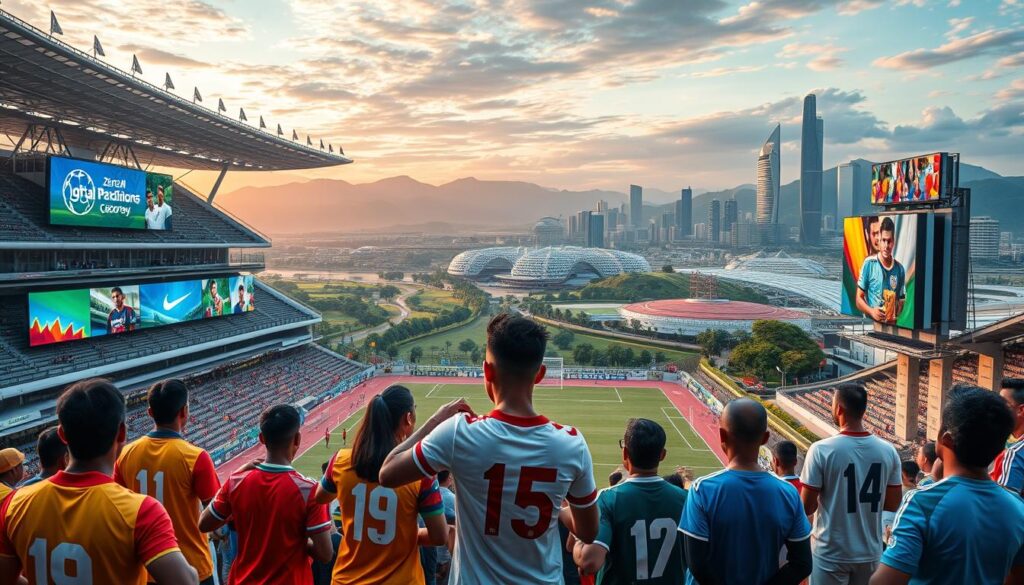
| Metric | Current Value | Projected Value after 2026 |
|---|---|---|
| Soccer Fans in the U.S. | 100 million | 140 million |
| MLS Fan Base Growth | 45 million | 60 million |
| Boston’s Economic Boost from World Cup | $1.1 billion | $1.1 billion |
Emerging markets represent one of the most vibrant frontiers for sports sponsorship, filled with untapped potential and rising demand.
With fan loyalty and economic growth on the rise, emerging markets will lead the future of sports sponsorship15.
The Importance of Data Analytics in Sports Sponsorship
Data analytics is key in sports sponsorship for better strategies and results. It helps brands understand fans and their behavior. This way, they can make smart choices to boost their presence in the market.
As the field grows, using analytics lets companies check how well their sponsorships work. They can see the return on investment (ROI) right away. This helps them plan better for the future.
The sports world shows a clear link between events and travel. Sports events are a big draw, with 63% of people seeing them as a top reason to travel. In 2023, sports-related travel hit 205 million, showing the big impact for brands in sports sponsorships3.
Esports is also growing fast, showing how data can improve player skills and guide marketing. It has moved from small groups to a global phenomenon18.
Social media analytics are also key, as they track things like how engaged people are and how far content spreads19. Sponsorships now focus on real partnerships and shared values. Using data analytics keeps your strategies sharp and up-to-date in the changing sports marketing world.

